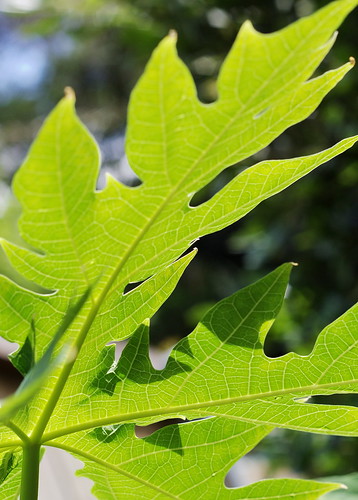Paw Paw Fruit Trees
I never thought about growing exotic fruit like the Paw Paw That was until I saw a tree for sale in Thompson Morgan’s catalogue. The sun accentuates the intricate pattern in this paw paw leaf.
Asimina triloba Papaw or North American Paw Paw
- This hardy pawpaw produces solitary, cup-shaped flowers and large, exotic foliage.
- During long, hot summers it will produce edible fruits with a delicious, tropical flavour, that can be harvested from September.
- In cool climates the Paw paw or Red Indian Banana forms an attractive multi-stemmed plant that makes an unusual addition to the shrub border with its buttery yellow autumn foliage.
- Pawpaws are self fertile, and pollinated by insects, however the chances of pollination will improve when growing more than one paw paw.
- Alternatively the flowers can be hand pollinated.
- Height and spread to 19’ so they do need a spacious garden.
- Happiest in full sun or dappled shade
‘Pawpaw (Asimina) is a genus of small clustered trees with large leaves and fruit. Growth Habit: The pawpaw is a deciduous, often narrowly conical tree growing from about 12 feet to around 20 feet. Pawpaw trees are prone to producing root suckers a few feet from the trunk. When these are permitted to grow, the single-clone pawpaw patch comes into being. The prevailing experiences of many individuals is that the pawpaw is a slow grower, particularly when it is young. However, under optimal greenhouse conditions, including photo-period extension light of approximately 16 hours, top growth of up to 5 feet can be attained in three months.
Foliage: The dark green, obovate-oblong, drooping leaves grow up to 12 inches long, giving the pawpaw an interesting tropical appearance. The leaves turn yellow and begin to fall in mid-autumn and leaf out again in late spring after the tree has bloomed.
Flowers: Dormant, velvety, dark brown flower buds develop in the axils of the previous years’ leaves. They produce maroon, upside-down flowers up to 2 inches across. The normal bloom period consists of about 6 weeks during March to May depending on variety, latitude and climatic conditions. The blossom consists of 2 whorls of 3 petals each, and the calyx has 3 sepals. Each flower contains several ovaries which explains why a single flower can produce multiple fruits.
Fruit: The pawpaw is the largest edible fruit native to America. Individual fruits weigh 5 to 16 ounces and are 3 to 6 inches in length. The larger sizes will appear plump, similar to the mango. The fruit usually has 10 to 14 seeds in two rows. The brownish to blackish seeds are shaped like lima beans, with a length of 1/2 to 1-1/2 inches. Pawpaw fruits often occur as clusters of up to nine individual fruits. The ripe fruit is soft and thin skinned.’
Sources Creative Commons
Paw Paw by unpodimondo, on flickr
Leaf and comments by Degilbo on flickr, on Flickr – Seems to really know his or her stuff

